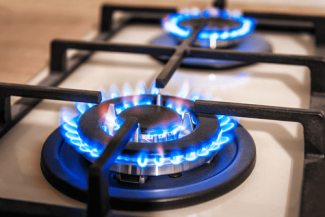Wait, What’s Going On With the Gas Stove Ban?
No, the federal government isn’t coming for your gas stove. But new legislation and research could point the way to an electric future
 Blue teardrop-shaped flames heating the underside of a skillet is one of the kitchen’s most hypnotizing sights. So, when a rumored gas stove ban began swirling earlier this year, fueled by comments from Richard L. Trumka Jr. of the US Consumer Product Safety Commission, the public was instantly whipped into a frenzy over the potential loss of their comforting cooking rituals. But could such a mandate be implemented?
Blue teardrop-shaped flames heating the underside of a skillet is one of the kitchen’s most hypnotizing sights. So, when a rumored gas stove ban began swirling earlier this year, fueled by comments from Richard L. Trumka Jr. of the US Consumer Product Safety Commission, the public was instantly whipped into a frenzy over the potential loss of their comforting cooking rituals. But could such a mandate be implemented?
The short answer is no. Despite the hysteria stirred up by pundits and politicians who swore that government bureaucrats would pry your gas stove from the wall, the roughly 40% of Americans who own gas stoves have nothing to fear. In fact, a provision in the Inflation Reduction Act specifies that the government will pay you in the form of an $840 rebate should you decide to voluntarily switch from gas to electric.
That’s not to say that certain states and municipalities aren’t planning for a future with far fewer gas stoves. As part of its budgeting process, New York’s state legislature passed a measure this week which aims “to phase out the use of fossil fuels in new buildings.” The legislation would forbid the installation of any gas-powered stoves, furnaces, or propane heating in any new building under seven stories tall by 2026, with similar requirements for taller buildings kicking in by 2029.
Certain larger commercial buildings (including hospitals, laundromats, and restaurants) would be exempt from these rules, and, importantly, no buildings standing today would suddenly need to swap their stoves. However, the hope is that banning gas stoves, furnaces, and the like from new construction will eventually make a sizable dent in the 32% of New York’s total emissions generated by buildings. Similarly, Maryland, Colorado, and more than 80 municipalities from coast to coast have either approved or are in the process of considering similar measures.
This facet of New York’s 2023/24 budget should be welcome news to Bill Caleo, founder of the Brooklyn Home Company, a New York builder that embraces Passive House principles. “The Brooklyn Home Company desires to promote renewable energy sources and reduce indoor air pollution, making electric the right choice,” he tells AD PRO. “With these goals in mind, we have been focused on selling all-electric buildings for some time when building new development condominiums and rentals.” (Good-looking Bertazzoni induction ranges are mainstays in Brooklyn Home Company projects.)
Paying Too Much For Insurance?
Get a FREE quote to insure your rental properties for less.
With Los Angeles among the cities set to limit gas stoves in new construction, AD PRO Directory designer Leah Alexander, who heads the Atlanta- and Los Angeles–based studio Beauty Is Abundant, is another designer who’s ahead of the curve. She recently capped her existing gas line and installed a Samsung Bespoke electric stove as part of her own home’s ongoing renovation, enjoying how a ductless vent creates “flexibility for the kitchen layout,” not to mention the end of grates clogged with food debries. “It’s proving convenient and sleek with its smooth, easy-to-clean surface.” But there is one caveat: Electric burners stain more easily than durable gas options, Alexander notes.
At the federal level, the debate over gas and electric stoves has less to do with legislation than with research. Alexander Hoehn-Soric, chair of the USCPSC, confirmed as much around the time of the initial controversy earlier this year, noting efforts to ramp up research efforts and determine ways of minimizing the hazardous effects indoors, like mounting range hoods.
The importance of exploring the connection between gas stoves and health outcomes has been affirmed by multiple recent studies. For example, Consumer Reports tested emissions and found nitrogen dioxide levels that exceeded the levels recommended by the World Health Organization. Carbon monoxide and particulate matter are also unleashed, all of them linked to respiratory illness (a peer-reviewed International Journal of Environmental Research and Public Health study connected nearly 13% of childhood asthma cases to gas-burning stoves).
Stanford University also made the startling discovery that even when these ranges aren’t in use, they leak methane, a potent greenhouse gas. Along with health risks, the effects on climate change are profound, prompting more than 50 cities and counties in California last year to put the kibosh on gas hookups in new buildings.
Driving widespread adoption of electric stoves will require shedding the perception that they’re slow and precarious, but emergent technology could help put these stoves on par with their gas counterparts as far as quality and reliability is concerned.
“Gas has been the preferred method of cooking for serious chefs. Historically, it’s more effective—ready, fast, and hot—than other methods,” explains Dan Mazzarini, creative director and principal of the bicoastal firm BHDM Design. But he’s encountered many proficient models as of late, like the Frigidaire Professional 30-inch Front Control he added during a revamp of his New York apartment: “The oven regulates the temperature more accurately than the gas counterparts. We also love the air-frying and convection features”—even if water takes a little longer to boil.
Even professional chefs are becoming fans. At Mr. Tuna in Portland, Maine, owner Jordan Rubin uses numerous electric induction burners. “They are a crucial part of our operation,” he says. “They have gotten a lot better over the years and can be set to a precise temperature—and after a long shift, I love how little mess they leave.”
Source: ADPro















 Accessibility
Accessibility